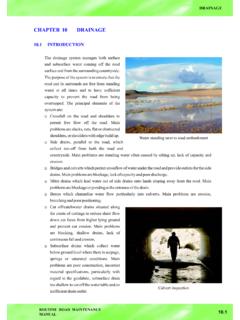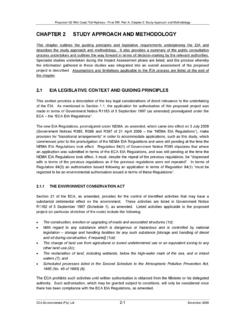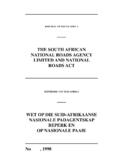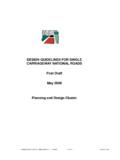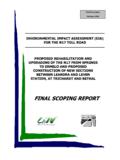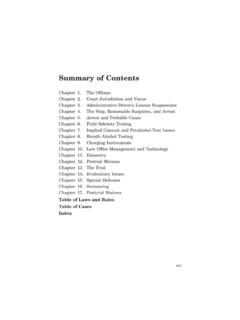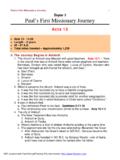Transcription of SOUTH AFRICAN PAVEMENT ENGINEERING MANUAL …
1 SOUTH AFRICAN PAVEMENT ENGINEERING MANUAL chapter 11 Documentation and Tendering AN INITIATIVE OF THE SOUTH AFRICAN NATIONAL ROADS AGENCY LTD Date of Issue: January 2013 Revision SOUTH AFRICAN PAVEMENT ENGINEERING MANUAL chapter 11: Documentation and Tendering 2013 SOUTH AFRICAN National Roads Agency Ltd. All rights reserved. First edition published 2013 Printed in the Republic of SOUTH Africa SET: ISBN 978-1-920611-00-2 chapter : ISBN 978-1-920611-11-8 SOUTH AFRICAN PAVEMENT ENGINEERING MANUAL chapter 11 Documentation and Tendering AN INITIATIVE OF THE SOUTH AFRICAN NATIONAL ROADS AGENCY LTD Date of Issue: January 2013 Revision 1.
2 Introduction2. PAVEMENT Composition and Behaviour3. Materials Testing4. Standards5. Laboratory Management6. Road Prism and PAVEMENT Investigations7. Geotechnical Investigations and Design Considerations8. Material Sources9. Materials Utilisation and Design10. PAVEMENT Design11. Documentation and Tendering12. Construction Equipment and Method Guidelines13. Acceptance Control14. Post-ConstructionBACKGROUNDTESTING AND LABORATORYINVESTIGATIONDESIGNDOCUMENTATI ONANDTENDERINGIMPLEMENTATIONQUALITY MANAGEMENTPOST CONSTRUCTION You are hereSouth AFRICAN PAVEMENT ENGINEERING MANUAL chapter 11: Documentation and Tendering Preliminary Sections Page ii SCOPE The SOUTH AFRICAN PAVEMENT ENGINEERING MANUAL (SAPEM) is a reference MANUAL for all aspects of PAVEMENT ENGINEERING .
3 SAPEM is a best practice guide. There are many appropriate manuals and guidelines available for PAVEMENT ENGINEERING , which SAPEM does not replace. Rather, SAPEM provides details on these references, and where necessary, provides guidelines on their appropriate use. Where a topic is adequately covered in another guideline, the reference is provided. SAPEM strives to provide explanations of the basic concepts and terminology used in PAVEMENT ENGINEERING , and provides background information to the concepts and theories commonly used. SAPEM is appropriate for use at National, Provincial and Municipal level, as well as in the Metros.
4 SAPEM is a valuable education and training tool, and is recommended reading for all entry level engineers, technologists and technicians involved in the PAVEMENT ENGINEERING industry. SAPEM is also useful for practising engineers who would like to access the latest appropriate reference guideline. SAPEM consists of 14 chapters. A brief description of each chapter is given below to provide the context for this chapter , chapter 11. chapter 1: Introduction discusses the application of this SAPEM MANUAL , and the institutional responsibilities, statutory requirements, and, planning and time scheduling for PAVEMENT ENGINEERING projects. A glossary of terms and abbreviations used in all the SAPEM chapters is included in Appendix A.
5 chapter 2: PAVEMENT Composition and Behaviour includes discussion on the history and basic principles of roads. Typical PAVEMENT structures, material characteristics and PAVEMENT types are given. The development of PAVEMENT distress and the functional performance of pavements are explained. As an introduction, and background for reference with other chapters, the basic principles of mechanics of materials and material science are outlined. chapter 3: Materials Testing presents the tests used for all material types used in PAVEMENT structures. The tests are briefly described, and reference is made to the test number and where to obtain the full test method.
6 Where possible and applicable, interesting observations or experiences with the tests are mentioned. Chapters 3 and 4 are complementary. chapter 4: Standards follows the same format as chapter 3, but discusses the standards used for the various tests. This includes applicable limits (minimum and maximum values) for test results. Material classification systems are given, as are guidelines on mix and materials composition. chapter 5: Laboratory Management covers laboratory quality management, testing personnel, test methods, and the testing environment and equipment. Quality assurance issues, and health, safety and the environment are also discussed.
7 chapter 6: Road Prism and PAVEMENT Investigation discusses all aspects of the road prism and PAVEMENT investigations, including legal and environmental requirements, materials testing, and the reporting of the investigations. Chapters 6 and 7 are complementary. chapter 7: Geotechnical Investigations and Design Considerations covers the investigations into potential problem subgrades, fills, cuts, structures and tunnels. Guidelines for the reporting of the investigations are provided. chapter 8: Material Sources provides information for sourcing materials from project quarries and borrow pits, commercial materials sources and alternative sources.
8 chapter 9: Materials Utilisation and Design discusses materials in the roadbed, earthworks (including cuts and fills) and all the PAVEMENT layers, including soils and gravels, crushed stones, cementitious materials, primes, stone precoating fluids and tack coats, bituminous binders, bitumen stabilised materials, asphalt, spray seals and micro surfacings, concrete, proprietary and certified products and block paving. The mix designs of all materials are discussed. chapter 10: PAVEMENT Design presents the philosophy of PAVEMENT design, methods of estimating design traffic and the PAVEMENT investigation process. Methods of structural capacity estimation for flexible, rigid and concrete block pavements are discussed.
9 chapter 11: Documentation and Tendering covers the different forms of contracts typical for road PAVEMENT projects, including conventional contracts, PAVEMENT performance guarantee systems, design and construct, and SOUTH AFRICAN PAVEMENT ENGINEERING MANUAL chapter 11: Documentation and Tendering Preliminary Sections Page iii concessions. In the documentation sections, the design, contract and tender documentation are discussed. The tender process is also discussed, from pre-qualification, through site inspection, to tendering and tender evaluation. chapter 12: Construction Equipment and Method Guidelines presents the nature and requirements of construction equipment and different methods of construction.
10 The construction of trial sections is also discussed. Chapters 12 and 13 are complementary, with chapter 12 covering the proactive components of road construction, , the method of construction. chapter 13 covers the reactive components, , checking the construction is done correctly. chapter 13: Quality Management includes acceptance control processes, and quality plans. All the PAVEMENT layers and the road prism are discussed. The documentation involved in quality management is also discussed, and where applicable, provided. chapter 14: Post-Construction incorporates the monitoring of pavements during the service life, the causes and mechanisms of distress, and the concepts of maintenance, rehabilitation and reconstruction.

